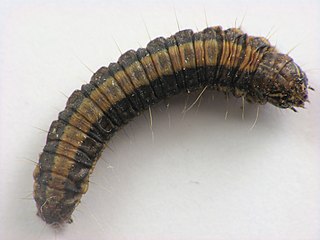
The Elachistidae are a family of small moths in the superfamily Gelechioidea. Some authors lump about 3,300 species in eight subfamilies here, but this arrangement almost certainly results in a massively paraphyletic and completely unnatural assemblage, united merely by symplesiomorphies retained from the first gelechioid moths.

Pyraustinae is a large subfamily of the lepidopteran family Crambidae, the crambid snout moths. It currently includes over 1,400 species; most of them tropical but some found in temperate regions including both North America and Europe.

States Rights Gist was a lawyer, a militia general in South Carolina, and a Confederate Army brigadier general who served during the American Civil War. A relative of several prominent South Carolinians, Gist rose to fame during the war but was killed at the Battle of Franklin on November 30, 1864. His name was based on the Southern states’ rights doctrine of nullification politics of his father, Nathaniel Gist. Nathaniel Gist was a disciple of John C. Calhoun and chose his son's name to reflect his own political sentiments.

Spilomelinae is a very species-rich subfamily of the lepidopteran family Crambidae, the crambid snout moths. With 4,132 described species in 340 genera worldwide, it is the most speciose group among pyraloids.

Crambinae is a large subfamily of the lepidopteran family Crambidae, the crambid snout moths. It currently includes over 1,800 species worldwide. The larvae are root feeders or stem borers, mostly on grasses. A few species are pests of sod grasses, maize, sugar cane, rice, and other Poaceae. The monophyly of this group is supported by the structure of the tympanal organs and the phallus attached medially to the juxta, as well as genetic analyses.

Orthonama obstipata, the gem, is a moth of the family Geometridae. The species was first described by Johan Christian Fabricius in 1794. It is a cosmopolitan species. In continental Europe though in the northeast, its range does not significantly extend beyond the Baltic region and it is absent from northern Russia. This well-flying species is prone to vagrancy and able to cross considerable distances of open sea; it can thus be regularly found on the British Isles and even on Iceland.

Scirpophaga is a genus of moths of the family Crambidae described by Georg Friedrich Treitschke in 1832. Asian species include significant rice stemborer pests.

Gyrtona is a genus of moths of the family Euteliidae first described by Francis Walker in 1863.

Plecoptera is a genus of moths of the family Erebidae. It was described by Achille Guenée in 1852.

Hypomecis is a genus of moths in the family Geometridae first described by Jacob Hübner in 1821.

Aeolanthes is a genus of small moths in the superfamily Gelechioidea.

The Chrysauginae are a subfamily of snout moths. They are primarily Neotropical and include about 400 described species.

The Epipaschiinae are a subfamily of snout moths. Almost 600 species are known today, which are found mainly in the tropics and subtropics. Some occur in temperate regions, but the subfamily is apparently completely absent from Europe, at least as native species. A few Epipaschiinae are crop pests that may occasionally become economically significant.

The Phycitini are a tribe of moths of the family Pyralidae.

Phazaca is a genus of moths in the family Uraniidae first described by Walker in 1863.

Odontiinae is a subfamily of moths of the family Crambidae. The subfamily was described by Achille Guenée in 1854.
Compsoctena ursulella is a moth in the family Eriocottidae. It was described by Francis Walker in 1863. It is found in Sierra Leone.
Aeolanthes diacritica is a moth of the family Depressariidae. It is found in India (Assam).
Agroterini is a tribe of the species-rich subfamily Spilomelinae in the pyraloid moth family Crambidae. The tribe was erected by Alexandre Noël Charles Acloque in 1897.

Margaroniini is a tribe of the species-rich subfamily Spilomelinae in the pyraloid moth family Crambidae. The tribe was erected by Charles Swinhoe and Everard Charles Cotes in 1889.
















